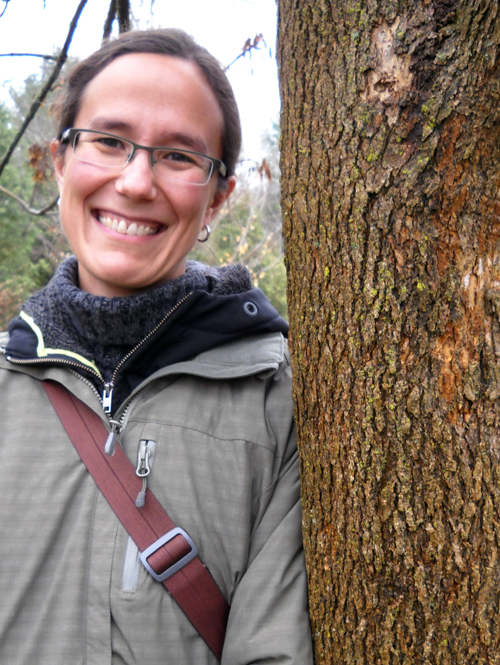
Scattered among a few pockets around southern Ontario, blue ash is among the most endangered trees in the province. But a conservation project based partly at the University of Guelph Arboretum might not only rescue this species but also yield specimens resistant to an insect pest that has felled other ashes during the past decade.
Helping rejuvenate blue ash in Ontario is the goal of a seed-harvesting initiative that brought volunteers to the arboretum one day last semester. Their effort yielded a “bumper crop of seeds” from a decades-old plantation that is now among the most important groups of blue ash in the province, says Prof. Shelley Hunt, arboretum director.
Those seeds will be sent to planting groups around Ontario in an effort to reverse the trees’ decline.
Blue ash extends from southwestern Ontario to Oklahoma and Georgia, according to the Ontario Ministry of Natural Resources, which lists the tree under the province’s Endangered Species Act. Some populations are protected in national and provincial parks; remaining trees on private land are not.
Clearing for farmland has brought the species close to extinction in Canada. “The forest land is chopped up into chunks, so you have these isolated populations of trees over the landscape,” says Hunt.
Along with arboretum horticulturalist Sean Fox, she enlisted undergrads from her environmental sciences class and arboretum volunteers to help collect seed last fall.
As blue ash populations dwindle, genetic diversity is also lost, making the species more vulnerable to environmental change, pests or disease, says Hunt. “Genetic diversity is so important to conserve. It gives the species a fighting chance for the future.”
Adds John Ambrose, the arboretum’s curator from 1974 to 1991, “It’s part of the diversity and the complexity of life that supports us. It’s not just having a nice environment to live in. It’s the systems we depend on.”
He established today’s blue ash plantation on campus with seed collected from almost two dozen sites around Ontario. The species favours floodplains such as the Thames River valley around London and limestone outcrops around Lake Erie.
He worked with late horticulturalist Henry Kock to plant seedlings in the arboretum. Today that plantation consists of about two dozen trees, many standing two or three storeys high.
That collection is part of the Ontario Rare Woody Plant Program run by the arboretum since 1979. Under that program, staffers collected more than 20 species now grown on campus as a living gene bank of rare trees and shrubs, including Kentucky coffee tree, Eastern flowering dogwood and cucumber tree.
The Guelph plantation holds one of the most significant collections of blue ash in the province, says Barb Boysen, co-ordinator of the Ontario Forest Gene Conservation Association in Peterborough.
Knowing where those specimens came from is crucial for recovery efforts, she says. “The beauty of what John Ambrose set up in the arboretum mandate is that those are collections that we know the source of. Seed source documentation and monitoring is really central.”
Not only is that useful today, Boysen says, but having a reference population will also help in introducing the species to new potential growing areas with climate change.
“We know so little about winners and losers. Blue ash may be uncommon now, but under climate change, it may be a great species. The more options we can keep, the better.”
Another benefit of blue ash may be its resistance to the emerald ash borer, an insect that threatens to wipe out other ash species across North America.
Shelley Carson, a PhD candidate in environmental sciences, found the beetle decimated green ash trees in Point Pelee even as it left neighbouring blue ash almost untouched.
The insect was detected in the southernmost portion of mainland Canada in 2007.
Following yearly data for mixed blue and green ash in her study plot at Point Pelee, Carson saw all 31 green ash specimens succumb to the pest. Only two of some 60 blue ash trees were affected, even among specimens growing side by side with green ash.
Researchers including her supervisor, Prof. Gard Otis, have seen similar results in Point Pelee and other locations in southwestern Ontario.
The beetles may dislike laying their eggs on blue ash, says Carson, or maybe some substance in the trees prevents the insect larvae from maturing.
She defended her thesis last fall. “This is further support for the argument that blue ash do seem to have some tolerance or resistance to the beetle.”
Besides potential resistance, says Ambrose, “blue ash is most drought-tolerant. It’s well-adapted for cities and hot, dry locations.”